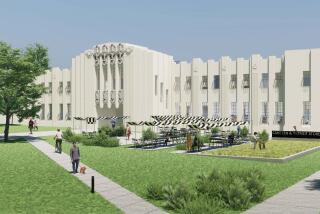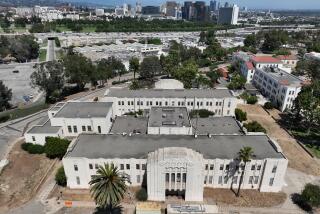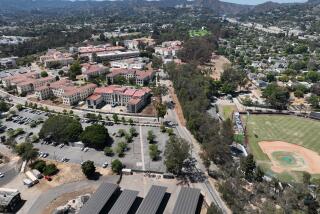West L.A. VA home to break ground
Rarely does a Westside construction project fail to provoke a NIMBY shout from one sector or another. But elation, not protests, will greet bulldozers next week as they begin ripping out parking lots and demolishing old buildings on the West Los Angeles Veterans Affairs campus to make way for a new state Veterans Home.
“There was absolutely no opposition to this,” said Los Angeles County Supervisor Zev Yaroslavsky. “Homeowners signed on, chambers of commerce, elected officials. We wanted it; we need it.”
Gov. Arnold Schwarzenegger and Jim Nicholson, secretary of the federal Department of Veterans Affairs, are expected to be among the dignitaries appearing at the project’s groundbreaking Friday.
The 396-bed, $183-million facility, slated to open in spring 2010, is one of five new veterans homes planned for California, which the federal VA acknowledged years ago was in “great need” of additional residential facilities. Work began in mid-June on satellite homes in Ventura and Lancaster, and two others are planned, in Fresno and Redding.
Support for the new state-sponsored homes reflects the recognition that California’s large and aging population of military veterans has strained the system created to support it. About 400,000 of California’s 2.2 million veterans live in the greater Los Angeles area, according to the California Department of Veterans Affairs. Many of them are homeless. The state now has just three veterans homes, in Chula Vista, Barstow and Yountville.
Recognizing the disparity, voters in 2000 approved the Veterans’ Bond Act. State legislators subsequently passed measures that made $120 million available to develop and build the five new state homes. The state money was required so the project could get matching funds from the federal Department of Veterans Affairs, which contributed nearly $180 million to construct the three homes in Southern California and deeded over to the state the 13.7-acre site at the West Los Angeles campus.
The matching fund system was “established to show a commitment to the project on the part of the state receiving the grant funding,” a federal VA spokesman said.
The unified support of Brentwood and Westwood residents for the project stands in sharp contrast to their frequent staunch opposition over the last decade to proposals by the federal VA to commercialize the property. Raising residents’ ire, the VA once proposed erecting a professional football stadium on the property. Consultants have also suggested hotels and mixed-use projects.
The community has also sharply criticized the VA for allowing uses not directly related to serving veterans. Enterprise Rent-a-Car stores vehicles there, as does a bus company. Theaters operate on the grounds. Film shoots are common, as are fairs, festivals and other events. Neighbors say the events add to congestion and disrupt their lives.
Ralph D. Tillman, the VA’s director of asset management at the campus, says such arrangements provide about $5 million annually for repairs and improvements.
U.S. Sen. Dianne Feinstein (D-Calif.) and Rep. Henry A. Waxman (D-Los Angeles) have proposed legislation that would require the VA to create a master plan for the property. Such a plan is necessary, they say, to ensure that veterans, residents and other stakeholders know what future projects or renovations will occur and so the community can ensure that the VA does not plan any commercial development.
The new state Veterans Home will help return the campus to its roots. In 1887, with thousands of veterans of the Indian Wars and the Civil War in need of treatment and housing, Congress mandated a Pacific branch of the National Home for Disabled Volunteer Soldiers. A dozen Victorian dormitories rose on the gently sloping grounds to house vets in what became known as the National Soldiers Home.
The state Veterans Home will be north of Wilshire Boulevard at the western edge of the 388-acre campus, just south of the Brentwood Theater.
Designed by the Smith Group, based in San Francisco, the 372,000-square-foot home will provide 84 beds for residential care for the elderly, 252 skilled-nursing beds and 60 beds for long-term care of veterans with dementia disorders such as Alzheimer’s disease.
Even before construction begins, the project has received an honorable mention from Design for Senior Environments, a publication that covers nursing homes and long-term care management. The magazine praised the design, which is curved to make best use of the slender, awkwardly shaped site. The building will be organized into 10 residential “neighborhoods” grouped into three main areas, each with its own character and courtyard. Residential rooms are planned to provide as much privacy as possible. The facility will feature abundant natural light and lots of artwork.
Cindy Miscikowski, a former L.A. city councilwoman who represented areas near the VA campus, recalled that it was easy to muster backing for the Veterans Home. “There was a wildfire of support,” she said. “We wanted to demonstrate that we could support something and show the VA things they should be trying to do.”
Citizens and veterans groups joined forces with the state Department of Veterans Affairs to win the project. Community members, elected officials and veterans groups praised the state agency for soliciting residents’ views and staying in frequent communication.
“They came hat in hand to the community,” Yaroslavsky said, “not as dictators coming from Washington, but as stakeholders themselves in a highly impacted community.”
Keith Jeffreys, president of Citizens for Veterans’ Rights, said veterans “are very pleased that the state of California stepped up to the plate and did this.”
More to Read
Sign up for Essential California
The most important California stories and recommendations in your inbox every morning.
You may occasionally receive promotional content from the Los Angeles Times.











